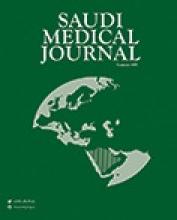Abstract
OBJECTIVE: To assess the pattern of use and impact of patient sitters on the quality of healthcare in Taif Armed Forces Hospital, Taif, Kingdom of Saudi Arabia (KSA).
METHODS: A cross-sectional survey was conducted at the Armed Forces Hospital, Taif Region, KSA from 1st January to 30th March 2008. The study included 203 admitted patients, 125 patient sitters, and 213 physicians and nurses. Three different questionnaires were specifically designed for each group of participants including information on the pattern and duration of patient sitting, and potential benefits and harm among sitters.
RESULTS: Approximately 58.4% of the participating sitters were women, 88% were Saudis, with age range from 17-60 years old, and mean (±standard deviation) of 33.0 (±9.64) years. More than 73% of the sitters have regular jobs. Types of the room and patient's age were the significant predictors for the presence of sitters. Patient satisfaction was not significantly associated with the presence, or absence of patient sitters.
CONCLUSION: Pattern and use of patient sitters in Saudi Arabia is unique where socio-cultural factors play the most important role. This study is another reminder to the healthcare system in KSA, as well as other Arab countries to develop policies that clearly specify patient criteria that support the decision of patient sitter use.
- Copyright: © Saudi Medical Journal
This is an open-access article distributed under the terms of the Creative Commons Attribution-Noncommercial-Share Alike 3.0 Unported, which permits unrestricted use, distribution, and reproduction in any medium, provided the original work is properly cited.






